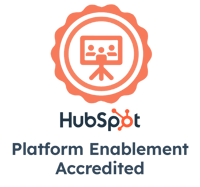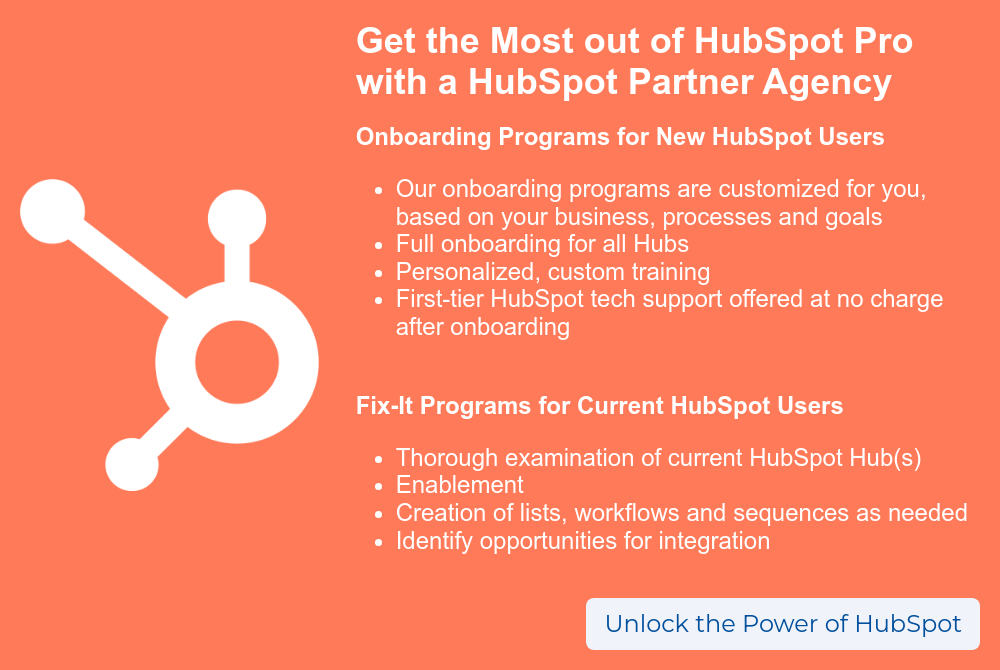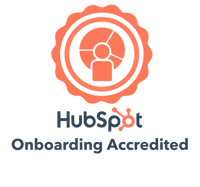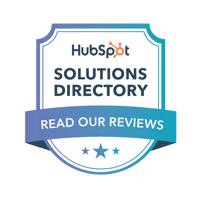If you're currently using HubSpot, one of your new years resolutions should include making my portal better: more streamlined, easier to use and filled with less junk.
BizzyWeb's HubSpot team has gathered some of the top tips for making the most of your portal this year, and to fit the theme of the new year, we've narrowed it down to 24 actions to take in 2024.
Follow these tips to help reach your new year's goal of a better HubSpot portal.
→ Related Content: Pimp My Portal: 10 Quick Tips to Make Your HubSpot Portal Sing
1. Check for product updates within HubSpot
Before you do anything else with your portal, get caught up on all the new features within HubSpot. HubSpot announced a big list of massive upcoming changes at their annual conference in 2023 - and now that we're in 2024, many of these tools have been implemented.
→ Related Content: Stay Ahead of the Curve: HubSpot Product Announcements from INBOUND23
2. Use the new AI tools
HubSpot added a suite of new AI tools within the system, and there are two you'll want to use right away: ChatSpot and Content Assistant. ChatSpot is an AI-powered sales and marketing assistant designed for businesses. It's powered by ChatGPT, but what makes ChatSpot different from other generative AI tools is that it connects to your current HubSpot account to tap into your specific sales, marketing and customer service data. Content Assistant appears in blog posts, emails and social media posts to provide content suggestions and AI-powered descriptions.
→ Related Content: 5 ChatSpot AI Prompts to Try
3. Review properties (+descriptions)
Reviewing your properties is a good clean-up task every year, but this year it got easier. Properties now have areas where you can add a description - and you should take the time to fill them out. While some fields like "cell phone number" are pretty self-evident, there are plenty of properties where it might not be so obvious what they mean - and a little extra detail can really improve your data.
4. Create custom actions for workflows
This is getting a little nerdy, but if you have a dedicated web development team you can use custom code to execute JavaScript or Python actions both inside and outside of HubSpot. Some examples are validating email addresses using an external service, managing a customer referral program, or translations.
➤ HS Tutorial: Custom code workflow actions
➤ HS Resource: Programmable automation use cases
5. Review page titles for landing pages
When you review your published landing pages, take the time to clear out old pages and improve the ones you keep. Are the internal titles optimized for clarity and organization? Are the public page titles optimized for SEO? The start of the year is a great opportunity to take another look at your landing page titles to make sure you're presenting interesting, action-oriented titles to get more clicks.
6. Set up + use the prospecting workspace
The prospecting workspace is a "cheat sheet" for sales staff and managers to have all the information they need in one spot and at a glance. If you haven't customized and used them, you're missing out. Explore our in-depth guide to the prospecting workspace to see what it does and how to get it running smoothly.
→ Related Content: How to Close Lagging Deals with HubSpot's Sales Prospecting Workspace
7. Create email suppression lists
Email suppression lists ensure you're not sending marketing emails to those who don't want to receive them while retaining their contact information in your CRM for other follow-up. You can use automation within HubSpot to create workflows that will automatically add someone to that list based on relevant criteria - including anyone who has unsubscribed from marketing communications, users who've marked your email as spam, or hard-bounced email addresses.
→ Related Content: The Non-Marketer's Guide to Segmentation & Targeting
8. Create Honeypots
Bots have gotten better at slipping through traditional defenses, which means more spam for all of us. You can create honeypots to help trap bot form fills. It's a bit technical, so I recommend checking out this guide from Thryv for a full breakdown of how it works and how to do it. In short, you're adding a hidden field that bots will see but real users won't, so if that field is filled out you know it's a bot and can set up a workflow to report them as spam.
→ Related Content: Honeypot Technique of Blocking Spam
9. Use association labels
You can use association labels to connect records within your database. The standard example is associating multiple contacts with the same company, but you might also use it for a number of applications: like associating a regional office to a business headquarters or different family members to one family. Using association labels pushes your CRM to the next level, giving you better data. You can even use association labels in workflows and email lists to target certain types of contacts with your marketing.
➤ HS Tutorial: Create and use association labels
10. Use automated SMS via workflows
HubSpot now has the option for you to use SMS (text message) communications right within a workflow. This is a fantastic way to further connect with your audience. Some examples might include sending an SMS appointment reminder 2 days prior to an appointment, sending an abandoned cart SMS or sending a members-only discount SMS. MessageIQ is another option for SMS within workflows, and since it was built for HubSpot, there is a bit more functionality you can use within the workflows tool (and it's more cost effective).
11. Tap into the power of Commerce Hub
HubSpot's Commerce Hub has been around for a while, but this year it saw some massive upgrades that make it more usable for B2B clients as well as B2C. Commerce Hub is the tool that allows you to take payments online within HubSpot, but it also now allows you to send quotes, invoices and set up subscription billing for auto-charging clients. This means you can use Commerce Hub for routine billing, not just eCommerce.
➤ HS Tutorial: Commerce software

12. Utilize Coaching Playlists
Sales enablement is a goal for many organizations in 2024, and with the coaching tools in Sales Hub it's even easier to get your new sales team members going. Coaching playlists can include call recordings, call snippets and notes that can be used for training purposes.
➤ HS Tutorial: Use coaching playlists to train your team
13. Explore Custom CRM Cards
Within HubSpot's CRM, each contact has a CRM card on the right side that displays internal data like deals, tickets and workflows associated with your contacts. Now you can also create custom CRM cards to display data from external apps or services. This is useful for tracking activity across tools like Jira, Salesforce, Proposify, Zoom, etc.
➤ HS Tutorial: How to set up and use HubSpot CRM cards
14. Use automated lead scoring
Lead scoring is an often under-utilized feature within HubSpot, but it can help marketing, sales, and service immensely. By assigning a score for any actions a prospect takes (be they demographic, company information, online behavior, email or social engagement), it provides a score for your contacts to show which ones are REALLY interested. For marketing, this helps them narrow the scope and target more effectively. For sales and service, it helps them know what language and supporting materials to use in conversion, and which leads to chase first.
➤ HS Tutorial: Lead scoring 101: how to use data to calculate a basic lead score
15. Use customizable views in the Conversations inbox
You can customize your view in several places within HubSpot - but users often ignore the Conversations inbox. By setting up custom views, you can filter data and streamline follow-up. One example that we recommend is ensuring that all conversations associated with high-priority tickets appear first so that service teams see them immediately.
➤ HS Tutorial: Organize conversations into custom views in the inbox
16. Review Goals and Forecasting
Forecasting was a tool that got some major upgrades this past year, so it's a good time to revisit it if you've been using it - and if you haven't, take this as your sign to get started. Forecasting lets you track your team's progress toward reaching goals. You can slice-and-dice forecasting data by deal amount, time period, team members and more. Your Sales professionals can even have a part in what gets forecasted and what doesn't.
➤ HS Tutorial: Set up the forecast tool
17. Funnel reports can support skipped stages
While it's still in beta as of the time of writing, this one is worth keeping an eye on: The new custom funnel report can allow you to skip lifecycle or deal stages. A use case would be if you want a marketing-qualified lead to skip straight into an opportunity vs. having to be updated to a sales-qualified lead first. This update to your reports will give you a more accurate lead count at any time.
➤ HS Product Update: New custom funnel report builder supports optional stages and company lifecycle stages
18. Update your scheduling options
The meetings tool received some major upgrades this past year, so now is a good time to review your meeting scheduler options and ensure they're tailored the needs of each team member. One of the big new features is the ability for visitors to add guests. This is a feature you can toggle on or off as needed by user.
➤ HS Tutorial: Create scheduling pages with the meetings tool
19. Schedule a meeting from inside a playbook
Playbooks allow you to create interactive content cards that display contact, company, deal and ticket information in one easy, quick-reference view. Many users don't realize you can now schedule meetings right from playbooks. Booking from playbooks makes sure reference information will appear on-screen when you meet with your contact - no searching needed.
➤ HS Tutorial: Use playbooks
20. Use conditional fields for properties
You can use conditional fields within your forms to collect more specific data from your contacts, but it's important to map everything correctly using properties to avoid confusion. Here's an example from HubSpot to illustrate how this works:
You may have a Department property to indicate the segment a contact works in, and a Role property to specify their job title. You can set up conditional options for the Role property so that if a contact's Department value is Engineering, the only options that will appear for Role are Engineer, Engineering Manager, and Director of Engineering.
➤ HS Tutorial: Set up conditional options for properties
21. Format custom properties
HubSpot comes with many built-in properties, but you may also need custom properties. However, over time and with multiple users you may end up with duplicates (for example: "Annual Revenue" vs "yearly revenue"). Take time at the start of the year to review, format and clean-up these custom properties.
➤ HS Tutorial: Create and edit properties
22. Make sure every workflow has a description
Workflows now allow you to add text explaining what the workflow does. Even if it seems obvious from the workflow name, filling descriptions out is vital. Adding descriptions helps avoid confusion, duplication and nullification with additional workflows.
23. Use custom views within workflows
As your business grows, so does the number of workflows - which can make finding what you need challenging. Using the Views tool within workflows, team members can filter workflows by type, creator, teams or external tool. For example, a marketing team member could create a view that only shows workflows associated with an inbound campaign, webinar or marketing push.
➤ HS Tutorial: Organize your workflows
24. Hire a HubSpot Partner for an audit
Ensuring your sales and marketing systems are optimized often requires spending hours of your time or pulling team members away from vital duties to help with data clean-up. If you don't have spare time (and who does!), you can lean on HubSpot experts who will conduct an in-depth audit of all of your Hubs, provide recommendations and implement those recommendations - with minimal time investment on your end.
 BizzyWeb is a HubSpot Platinum Partner: we offer full-service HubSpot onboarding, enablement and strategy for all hubs. Our team has over 196 certifications in HubSpot (and constantly growing). No matter what your HubSpot needs are, our team is ready to handle them.
BizzyWeb is a HubSpot Platinum Partner: we offer full-service HubSpot onboarding, enablement and strategy for all hubs. Our team has over 196 certifications in HubSpot (and constantly growing). No matter what your HubSpot needs are, our team is ready to handle them.
Plus, we are the only agency in Minnesota with a Platform Enablement Accreditation from HubSpot - sounds fancy, but it means we're top-notch in making HubSpot work within your business.
BizzyWeb is a Minneapolis-based digital marketing and web design agency that helps companies get the high-quality leads they need to grow and thrive. Our tactics include inbound marketing, SEO, advertising, web design, content creation and sales automation. We are an accredited HubSpot Platinum Partner and we offer full-service HubSpot onboarding, enablement and strategy for new and current users.






